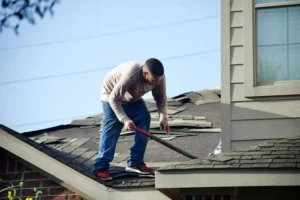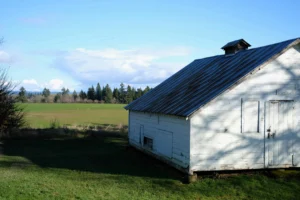Roofing projects can be a little unpredictable. Sometimes, unexpected weather delays or other circumstances can leave shingle bundles sitting on your roof longer than you anticipated. But for how long is considered to be too long? In this blog post, we’ll explore factors that affect the lifespan of exposed shingles. We shall discuss the possible risks of having your shingles exposed to direct sun and rain and give you a few suggestions on protecting your investment. Therefore, whether you are a DIY expert or a homeowner who hired a contractor to do his job, here’s what you need to do for your shingles to be in good condition for a long time.
Table of Contents
ToggleUnderstanding the Number of Shingles in a Bundle
A bundle of roofing shingles can hold anywhere from 15 to 29 shingles. Generally, the standard asphalt shingles, being the thinner and more economical ones, are sold in bundles with 21 and 29 pieces of shingles.
Architectural shingles are liked for the added thickness and dimensional appearance. They come in 15 to 22 shingles in a bundle. The lower numbers mean more size and weight, but you lose in quantity, you win in durability and curb appeal.
Determining the Right Amount of Roofing Nails per Bundle
The number of nails for each bundle is determined by conditions such as the kind of shingle, weather condition, and installation instructions. Usually, for asphalt shingles, the normal conditions have four nails per shingle; this is approximately 320 nails per square, whereas, for high wind areas, five to six nails are suggested to be used per shingle, increasing the total to approximately 480 nails per square.
To find the total nails needed, multiply the numbers of shingles per square by nails per shingle. Using a 29-shingle bundle yields 116 nails for one bundle and about 348 nails for three bundles per square. Roofing nails are sold by weight, and a 5-pound box contains approximately 978 nails of the 1-1/4 inch smooth shank type.
the Weight of a Bundle of Roofing Shingles
The weight of one bundle of shingles can range between 60 to 80 pounds, depending on the kind. Standard three-tab shingles are on the lighter side of the scale, making them easier to handle during installation.
Architectural shingles and luxury shingles are much heavier and can weigh up to 80 pounds or more due to their thickness and additional layers. This extra weight enables them to be more resistant to bad weather; however, this will also mean they should be carefully handled.
How Much Does a Bundle of Roofing Shingles Cost?
The prices of roofing shingles vary, depending on the type and brand; however, one bundle costs between $90 to $150. The regular asphalt is the cheapest, whereas the architectural shingle will be relatively more expensive in terms of quality and its esthetic value. Even though some premium quality shingles would cost a bit more for the initial expenses, their longevity, minimal maintenance and increased property value offset the up-front cost of the initial investment.
Calculating Shingle Bundle Requirements for Any Roofing Project
To determine how many bundles of roofing you’ll need, calculate the total square footage of your roof. Measure the length and width of the roof, then multiply those dimensions to get the area. For example, if the roof measures 30 feet by 40 feet, the total area would be 1,200 square feet.
Convert this to squares: divided by 100, such as 1,200 square feet divided by 100= 12 squares. For new installation, each square takes three bundles. Multiply the number of squares (12) by three equals 36 bundles. Add another 5-10% more (as waste for cuts or overlaps). Add 10% and you will approximately require an additional 4 bundles, making it 40 bundles in total.
Are Coverage Of Shingle Bundle
The approximate amount of area roof that a bundle of roofing shingles would need to cover the roof area is 33.3 square feet. This is the standard measure that allows homeowners and contractors to determine how many bundles they would need based on the size of their roofs. For example, if you computed that your roof area amounts to 1,200 square feet, you divide this number by 33.3 to obtain the number of bundles that you would need.
Life Of Shingle Bundle Stick On Roof
The life of shingles is usually 15 to 30 years based on quality, installation methods, and environmental conditions. Regular inspections and maintenance can stretch the time they can survive; however, extreme weather conditions will break them down earlier than usual. They must be checked from time to time and changed whenever they need it so that the roof will always remain perfect.
Choosing the Right Shingle Bundles for Your Roof
Choosing the right bundles of shingles for your roof is about the right balance between durability, esthetics, as well as budget. Here’s how you can choose the right shingle bundles for your next roofing project:
Know Your Shingle Types
There are lots of kinds of shingles, and each of them has its respective pros and cons. Three-tab shingles are less expensive; hence, more suitable for those having a small budget, while others are not too durable. Architectural shingles seem to have an abrupt appearance with a texture that speaks for a modern look and lasts longer. On the other hand, luxury shingles are meant for people wanting only the best quality since these promise unmatched longevity, elegance in style, and can best blend with upscale homes.
Consider Your Climate
Your roof is going to take on everything from blistering sun to heavy snow, so your shingles should be selected to take on whatever your region throws at them. If you live in an area prone to high winds or hail, look for impact-resistant shingles that won’t buckle under the pressure. And if you live in a damp climate, algae-resistant shingles will prevent unsightly streaks from forming.
Determine Your Budget
The roofing costs can surely add up once the work begins. You need to consider how much you will be able to spend by looking at the shingles themselves and the cost associated with professionals installing them. That way, you balance quality with affordability, getting the most value from your money without cutting corners in either esthetics or durability.
Check for esthetics
The roof is important in the general appeal of your house. Pick the shingle types to match the color and/or style of the home. Bring samples of products to your home to see their different features inside and outside of lighting and if they match your outdoor esthetics. Nicely selected shingles uplift the appeal and boost the resale value for sure.
Review Warranties
A good warranty gives confidence to the manufacturer in the product. Shingles with a warranty period of 25 years, or more will ensure a very long time of performance. Many brands also offer extended coverage with algae growth or wind damages.
Hire Professionals
It goes that installation is just as critical as the shingles themselves. Professional roofers ensure the roofing is done properly, helping to extend the life of a roof and avoid expensive repairs that could have been dealt with elsewhere. Professional roofing companies offer the added advantage of offering a warranty, covering your roofing with an extra layer of protection.
Calculate Quantity Needed
Have correct measurements taken of the area before the roofing begins, since shingles are sold per bundle-three bundles per hundred square feet. Knowing how precisely you need will keep you from overspending on the installation process.
Stacking of Shingle Bundles on a Roof
Proper stacking of shingle bundles is really important for reasons of safety, preservation of the integrity of your roof, and prevention of damages to the shingles. Always check the weather, and try not to stack in rain, snow, or high winds due to hazardous handling conditions.
Be aware of your roof load capacity, with each bundle weighing 75-80 pounds, and do not overload the roof. Distribute the bundles properly, as an even spread removes the additional burdens from any section of the roofing.
Keep the bundles away from valleys and edges, especially areas that would get damaged. Stack up to about nine bundles, as maximum, to prevent it from blowing over, and save your shingles from heat gain by keeping in shade whenever possible. On steep roofs, bundles would slide so just nail a board to keep them.
Finally, the shingles are carefully moved to avoid bending or breaking. This is most especially applicable for architectural shingles since they are thicker and would probably get out of place once dropped to the ground. In this regard, handling them carefully assures that they are in good enough condition to be installed.
Conclusion
Many factors will affect the length of time shingles can safely remain on a roof, such as weather, type of shingle, and manufacturer recommendations. Short-term exposure to rain or snow will typically not cause damage to shingles; however, long-term exposure to such harsh weather conditions may cause damage to shingles. It is, therefore, recommended that shingles be installed as soon as possible to minimize the potential damage and ensure maximum performance. Homeowners will benefit from the shingle roof investment by considering proper manufacturers’ guidelines in the maintenance of a shingle roof and local weather conditions.
Frequently Asked Questions
How many bundles of shingles does a 12×12 roof require?
A 12 by 12 roof equates to 144 square feet. Shingles, in general, are packed in bundles, which ought to cover an area around 33-34 square feet. So, you will have to buy around 5 bundles. Always budget a little extra in case some gets wasted or messed up during installation.
How many shingle bundles does it take for a 1,200 sq ft roof?
For a 1,200 square foot roof you are going to need around 36 bundles of shingles because each square or 100 square feet will need 3 bundles of shingles. Again, if using heavier architectural shingles, you may need even more. Don’t forget you will need extra shingles for the ridges and starter rows.
How many bundles of shingles does a 2,500 square foot roof require?
An area of about 2,500 square feet will need nearly 75 bundles of shingles since 1 square measure equal to 100 square feet and each square requires the use of 3 bundles. You may need to add extra bundles for complex roof shapes or cuts and overlaps of waste.
How many bundles of shingles are required for a 360 sq ft roof?
Normally, 11 to 12 bundles of shingles are required for a roof area of 360 square feet. That would be over 10 bundles because 3 bundles will cover 100 square feet.
How many squares are 56 bundles of shingles?
Since 1 square covers 100 square feet and is made up of 3 bundles, 56 bundles equal about 18.67 squares. That means this bundle will cover approximately 1,867 square feet of roof, which will be ideal for medium-sized roofing projects.







